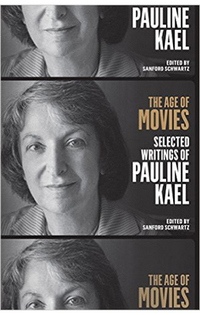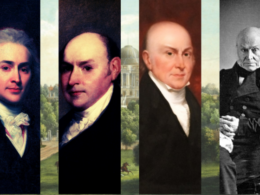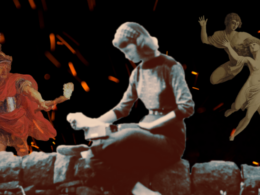
Sanford Schwartz, art critic and biographer, recently spoke with us about The Age of Movies: Selected Writings of Pauline Kael, which he edited for The Library of America.
LOA: Why a new collection of Pauline Kael’s writing, and why now?
Schwartz: I believe Pauline Kael has one of the truly distinctive voices in American criticism—American writing, really—and needs to have a representative selection of her writing continuously available. It is wonderful that The Library of America feels the same way. And then most of her own collections have been out of print.
LOA: What was your relationship to Kael, and how did she influence you as moviegoer, as critic, and as a writer?
Schwartz: We were good friends from the 1960s on. Like many people, I wanted to talk back to her reviews—her writing invited this—and so I wrote her now and then, and that is how our friendship began. Later, there was a period when we lived a few blocks from each other, and it was easy to get together. She was an immense influence in many ways. I didn’t always agree with her, of course, but I was so amazed by her aphoristic and witty style I rarely felt I could just dismiss her opinions. They got under my skin.
In my twenties I wanted to write movie criticism, and I sent her pieces for comment, which she freely, often stingingly, gave. Even after I eventually came to write about art, I often sent her pieces to look at. This was tricky, because she was a teacher of sorts, and a generous one, and she didn’t just read you: she judged every sentence. If I survived her scrutiny I felt armored and ready to take on my actual editor. When I read her letters in preparation for selecting pieces for The Age of Movies, I found that she was doing that same thing for whatever her friend Robert Duncan would send her, and she was in her early twenties at the time.
LOA: What was Kael’s impact on the cultural scene of the 1960s and 1970s?
Schwartz: I think she had less of an impact in the 1960s because at the beginning of the decade she was writing mostly for movie and small-circulation magazines and then, later in the decade, you didn’t know where she would pop up. Her greatest influence certainly came after she joined The New Yorker in 1968 and during the first two-thirds of the next decade, when American movies in particular were so exciting and demanding. Many commentators have described her principally in terms of the way she showed how you could write about a popular, mass-market form and find in it the aspirations and delusions of the culture as a whole. I don’t deny the importance of this. But for the majority of her readers, and this would be in the 1980s as well, her significance was that, whether she liked the film or not, she gave you, as no other writer did, the full experience of it.
LOA: Editing this volume, what new or previously underappreciated themes/qualities came into focus for you?
Schwartz: I don’t think that I was hit by anything I hadn’t already registered over the years. But I was surprised by how in piece after piece it was her evocations of actors, not directors, that stood out. I had also lost sight of her bias toward American as opposed to European movies.
LOA: What makes her writing alive today? How would you compare her, as a writer, to other film critics?
Schwartz: Her writing remains strong and pertinent because, beneath her wit, her slangy shrewdness, and her taste, there is a bedrock of emotional rightness and believability. It is there in her descriptions of actors and her convincing and absorbing dissections of storylines and character motivation. She had a larger subject than movies. It was behavior and how life can be enhanced. She isn’t a period writer. When we read her on films of the 1970s, say, we don’t get mired in that time. Her concerns will make her voice seem contemporary to many succeeding generations, I think.
LOA: Is it fair to characterize Kael as a champion of American film?
Schwartz: Yes, she did “champion” American movies, though it is important to realize that her approach was less polemical than a matter of temperament and taste. There was a particular kind of sparkling and largely verbal entertainment that she adored and that, as she saw it, only American films could provide. She was in her late teens—an impressionable time—in the late 1930s, when worldlier and livelier writers were giving Hollywood films a new verbal dynamism (and new sound techniques were enabling this to happen). I think the wit and speed of the movies of that moment got to her deeply. A standard was set for her for one of the things movies could do very well, and, of course, those movies embodied aspects of American life. European and Asian films were great to her in many ways, but they didn’t provide that dazzle. As it turned out, Hollywood, over the years, rarely did, either.
LOA: What were her influences and allegiances?
Schwartz: Kael wasn’t influenced in the sense that someone showed her a way. She was a born noticer and evaluator. She was a natural critic, even as a young person. That is clear in the letters she wrote in her early twenties. But she was certainly influenced by the way that, when she was in college and in the years after it, a number of literary critics—Trilling, Blackmur, Kazin, Burke, Jarrell—were taking wing. It was the moment when the literary review that was also a criticism of life and that presented a highly individual voice was coming of age in this country, and this kind of writing clearly gave her a sense of what she could do. She got a lot from Blackmur, as I note in the Introduction. There is also a good bit in Kael of Virginia Woolf, especially from the essays “On Not Knowing Greek” and “How Should One Read a Book?” Kael read everything by Woolf. A core distinction of Kael’s essay “Trash, Art, and the Movies”—the relation of art to entertainment—is there in “How Should One Read a Book?”
LOA: Which films and filmmakers sparked her most impassioned writing, and why?
Schwartz: She was on the lookout for huge, ambitious creators. Modest, well-meaning talents made her restless, though she was quick to see qualities in, say, Irvin Kershner or Fred Zinnemann, who, while much more than modest directors, were certainly self-effacing. With her powerful feeling for Melville, she was always receptive to filmmakers who wanted to take on the universe—as long as there wasn’t, as she saw it, a degree of solemnity, condescension, or sentimentality at the heart of their work (which doomed Chaplin for her). She responded to directors such as Renoir, Huston, Satyajit Ray, and Sam Peckinpah (though her high estimate of him always was a mystery to me) who were you might say full-blooded humanists; they were artists who came to conclusions through their senses. But she was as impassioned—in a negative way—about the films of Kubrick, say, or Fellini from the 1960s on, or John Cassavetes, or Claude Lanzmann, where she felt people and situations were not only subject to preexisting design schemes but schemes that denied spontaneity, nerviness, the individual voice.
LOA: What did she particularly look for or admire in actors?
Schwartz: I believe what drew her to actors of both sexes was when she saw what might be called a sexual responsiveness to life. She was after a happy avidity for experience and an unintimidating, non-calculating sense of self-reliance. She could, on the other hand, appreciate actors who tended to be neurotic or defensive, or even very measured and cerebral; she might even be warmly affectionate about them if, like Gielgud, they happened to be tremendous craftsmen and didn’t pretend to be other than what they were.
Actresses on their own drew yet another response from her. She liked comediennes, but she wanted to see an underlying stamina there, as there was in Katharine Hepburn’s comedy. Physical strength in actresses excited her. She seemed mesmerized by Vanessa Redgrave’s sheer physical largeness; and Kael’s celebrations of Streisand, Jane Fonda, Debra Winger, and so on right to Anjelica Huston have the quality of crush-like adorations combined with a sense of bravado and a threat directed to men—as if Kael were saying, “You’re not going to mess with these women.” Given her affinity for strong actresses, it is amazing how warmly she could describe so many types of male actors.
LOA: Which actors or filmmakers working today do you think Kael would especially like and respect?
Schwartz: A hard one. My favorite newish director may be Duncan Jones, who did Moon and Source Code. I’d like to think that Kael would find him exciting, but who knows? I would like to believe she would be enthusiastic about (to take some actors who have become prominent in recent years) Clive Owen, Maggie Gyllenhaal, Owen Wilson, Rebecca Hall, Brendan Gleeson, Catherine Keener, James Franco, Viola Davis, Jake Gyllenhaal, and Vince Vaughn. But maybe not. Next time she comes back in a dream, I’ll ask.



